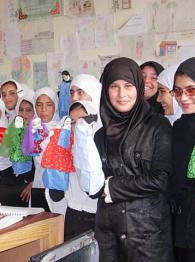
About the Project
This project is one of the 2014 WISE Awards finalists.
HTAC’s Peace Education Curriculum is the first formal school-based model to specifically target vulnerable middle-school and high-school students, encouraging them to reject violence and all forms of aggressive behavior while embracing the principles of peaceful living, respect for diversity, and cooperation.
Context and Issue
For over 30 years Afghan children have been innocent victims of a cycle of violence in civil war, invasion, and by extremist elements as well as violence in the home. Far too many have grown up in an environment of physical and emotional trauma. Left to themselves, many grow up believing that aggression is the only way to resolve conflicts, which in turn contributes to a culture of violence.
Afghan youth face serious challenges growing up in this war-torn country where aggression and violence in schools are regular features, and a majority of Afghan teachers still use corporal punishment. Fighting and harassment among ethnic groups is common, and at home, parents use violence and other abuse to discipline their children, especially girls.
Solution and Impact
HTAC’s program addresses the root causes of violence and aggression, and presents alternative behaviors based on respect, communication, and peaceful coexistence. It teaches respect for other ethnic groups, and it teaches boys and fathers to respect and honor the rights of girls and young women to quality education and a productive livelihood.
HTAC has developed an integrated learning model that provides Afghan youth with tools to apply non-violent approaches at school and in the home. The project model motivates Afghan teachers to abandon counter-productive corporal punishment and to create a safe learning environment for students. The initiative encourages and guides parents and community “shuras” (leadership councils) in supporting peace education in homes and neighborhoods.
HTAC’s peace education initiatives have shown impressive results. Analysis indicates that fighting and aggressive behavior among students decreased dramatically and that students consistently modeled positive behaviors. Most teachers had abandoned corporal punishment practices, and most parents used non-violent conflict resolution techniques modeled and taught by their children. Local communities leaders reported a significant drop in violent conflicts between neighbors and among ethnic groups after they learned about peaceful communication and mediation techniques.
Originally introduced in 2003 to three schools, the model has spread to 62 schools in five provinces, impacting over 86,000 boys and girls. Results from these schools over the past three years have shown a dramatic reduction in fighting, consistent improvement in classroom and schoolyard behavior, and similar reductions in teachers’ use of corporal punishment. In 2012, recognizing its potential to impact millions of students, Afghanistan’s Ministry of Education endorsed HTAC’s initiative to expand into other regions of the country.
Future Developments
In 2014 HTAC seeks to extend the reach of peace education to Jouzjan and Kabul provinces with the help of the Ministry of Education and several key international partners. The long-term objective is to accelerate the expansion of the curriculum to many provinces, impacting over one million students, ultimately making peace education available for all Afghan middle and high-school students.
HTAC and the Ministry of Education’s Curriculum Department continue to collaborate in developing the program. Over the past two years more international organizations and government agencies have recognized the far-reaching impact of peace education and have expressed interest in working with HTAC in delivering the program. HTAC will work with these partners to implement a planned, incremental expansion.


